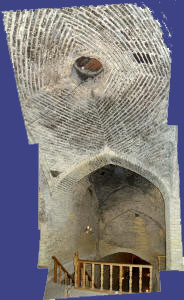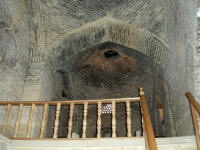|

141. An outside view of
Homa Hotel.
Though it is the only 5-star hotel in Shiraz, I couldn't find any
vegetarian dishes (except mushroom omelette) in its restaurants or
room service menu. |
"Pleasant is
Shiraz and its incomparable state;
Oh lord, preserve it from decline."
- Hafez (Translated from Persian)
|
|
|

142. An outside panoramic
view from the window of my room in the second floor of the hotel. |
|

|
 |
 |
 |
|
143. My room in Homa
Hotel |
144 to 146.
The Quran Gate originally built as an ornamental entrance by the Buyids or Buwayhids (945–1055 AD), an Iranian dynasty of Daylamite
(northern Iranian) origin, and was ignorantly demolished about 70
years ago. The present gate was erected on its site later by a local
merchant. |
|

147. The Quran Gate and
lights of the city of love, Shiraz. Travellers exiting the city
would pass under the gate as a tradition in beseeching protection
from the holy book for the course of their trip. A hand-written copy
of the Quran was actually kept on top of the gate which is kept
today at the Pars Museum in Shiraz. |

148. Another shot of
the Quran Gate. |
|
 |
 |
| 149 & 150.
Lights of the poetical capital of Iran, the city of love, and
the homeland of "Shiraz" wine. |
|

150. Residence of
Khaju-ye Kermani or Khaju of Kerman (1280-1352 AD), an Iranian
Sufi mystic
poet, now has been changed to a humble shop. |
 |
|
 |
 |
| 151, 152 & 153. A
promenade near the Quran Gate, somewhere like Darband in Tehran. |
|
 |
 |
 |
 |
| 154 to 157. A
traditional cafe and promenade near the Quran Gate, somewhere like
Darband in Tehran. |
|
 |
 |
 |
 |
| 158 to 161. "Ali ebn
e Hamzeh" old bridge on a dry river. |
|
 |
 |
 |
|
162 to 164. No reference to Shiraz would be
complete without mentioning the gardens of Shiraz, and the
nightingales that sing in its rose-bowers and inspired its immortal
poets. One the most beautiful and notable of these gardens is Eram... |
|

165. "Eram Garden" is a famous historic Persian garden in
Shiraz. Built in the
Qajar era by Mohammad-Gholi Khan e Ilkhani
including a very beautiful building constructed by
Mohammad-Hassan e Me'mar, the compound was used by the feudal
elite and tribal leaders of
Fars Province, and later used by the royalty of
Iran. The compound came under the protection of
Pahlavi University during the
Pahlavi era, and was used as the College of
Law. It is today still a property of
Shiraz University, and is open to the public as
a museum, protected by
Iran's Cultural Heritage Organization.
|
|
 |
 |
|
166 & 167. The building inside Eram Garden is an example of Qajarid
architecture. "Eram" is originally the name of a garden mentioned in
Quran and compared with Heaven. |
|

171. Inside Eram Garden |

168. A beautiful Orange tree in Eram Garden |

169. Inside Eram Garden |

170. Inside Eram Garden |
|

178. Inside Eram Garden |
 |
 |
|
172 & 173. Inside Eram Garden |
|

174. Pomegranate trees in Eram Garden |
 |
 |
|
175 & 176. Inside Eram Garden |
|

177. Inside Eram Garden |
 |
|
 |
 |
|
179 to 181. Inside Eram Garden |
|
 |
 |

186. Pomegranate trees in Eram Garden. Throughout the Orient, the
pomegranate has since earliest times occupied a position of
importance and is considered indigenous to Iran and neighbouring
countries. It was the symbol of love and fertility. |
|
182 & 183. Inside Eram Garden |
|

187. A very old cedar in Eram Garden |

184. Eram as a symbol of Persian Gardens and Qajarid architecture |

185. Nasir-ol-Molk Mosque is one of the most beautiful
mosques I have ever seen. |
|

188. Nasir-ol-Molk Mosque was built during the Qajar era by
the order of Mirza Hasan-Ali e Nasir-ol-Molk, one of the
lords of the Qajar Dynasty, in 1876 AD and was finished in 1888. |

189. Nasir-ol-Molk Mosque |
|

190. Inside view of Nasir-ol-Molk Mosque |
|

191. Inside view of Nasir-ol-Molk Mosque |

193. A window glasswork craftsmanship of the Nasir-ol-Molk Mosque
interiors |

197. Interior of the mosque |
|

192. Inside view of Nasir-ol-Molk Mosque |

195. The facade of the mosque |
|

194. The facade of the mosque |

196. Courtyard view |
|

198. Interior of the mosque |

199.
Another manifestation of colours
|

200. An outside view |

201. Another outside view |
|
 |
 |
|
 |
 |
 |
|
202 to 206. "Gav Chah" (=bull well), a place
in the mosque where water was drained out from a well by the power
of two bulls and reserved in a high-levelled reservoir to use in the
fountains of the mosque yard. |
|

207. A residence for the mosque attendants |

208. The building of Cultural Heritage Organisation of Shiraz |